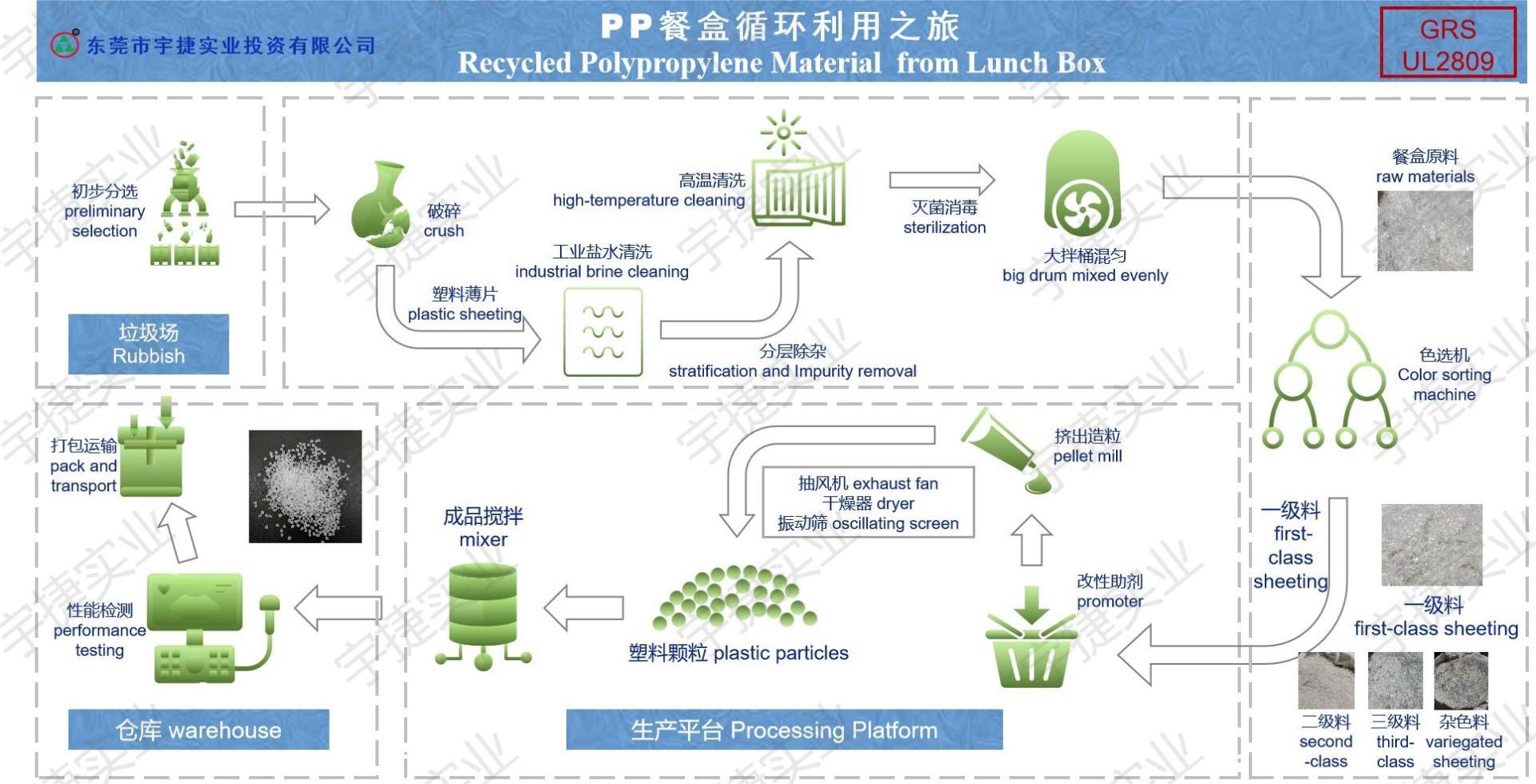Modification and Recycling Process of Recycled PP Polypropylene
Release time:
2023-04-04 11:34
Source:
In recent years, carbon neutrality policies, rising oil prices, and subsidies for new energy purchases for a period of time are all strengthening the general trend of new energy. According to the "New Energy Vehicle Industry Development Plan (2021-2035)", by 2035, China's new energy vehicle penetration rate will reach 50%. The rapid development of the electric vehicle industry has also led to the rise in the market of modified PP raw materials. Automotive parts, different types of reusable containers, plastic parts, packaging and labels, speakers, polymer banknotes, stationery, textiles, carpets, ropes and thermal underwear... all of the above have a common root. It is a polypropylene raw material, abbreviated as PP. PP is a recyclable thermoplastic polymer that is widely used in these applications. The global demand for polypropylene materials is quite high. Transparency market research shows that the current global polypropylene market is worth more than $80 billion. According to the research institute, it will reach $133.3 billion by 2023. Today we will briefly introduce the modification and recycling process of recycled PP polypropylene.

Polypropylene recycling is essential for the environment
Among all plastic packaging products in the UK and the United States, PP is the most used single plastic packaging, thanks to its melting point and strong bearing capacity. In 2010 alone, 5 billion pounds of polypropylene were produced in the United States. Unfortunately, the American Chemistry Council (American Chemistry Council) disclosed that PP is the lowest recovery rate of post-consumer plastics, and the recovery rate of post-consumer PP foam is less than 1%. This is bad for the environment.
Polypropylene has a short lifespan, so most thermoplastics are wasted in landfills. According to the US Environmental Protection Agency, about 20% of the solid waste generated contains some form of plastic, including polypropylene (PP). This solid waste containing polypropylene degrades very slowly in landfills and takes about 20 to 30 years to fully decompose. Naturally, this poses a serious threat to the environment. Additives used in plastic products may contain toxins such as lead and cadmium. Cadmium contained in plastic products has the potential to penetrate and affect certain biological systems. If you burn a thermoplastic such as PP, it will expel toxins and vinyl chloride. In this context, recycled polypropylene is of great significance.
Polypropylene Recycling Process
The polypropylene recycling process includes collecting, sorting, cleaning, melt reprocessing, and then producing new products from the recycled polypropylene. Melt reprocessing and reusing recycled polypropylene to produce new products are important steps in the polypropylene recycling process. In the post-treatment stage, the collected polypropylene product is fed to an extruder where it is melted and cut into pellets. Use a special extruder for granulation. Granulation includes cold water granulation or air cooling granulation. The packaging is then labeled. Finally the pellets are ready for use in the production of new products.
Specifically, the polypropylene recycling process can be divided into two types, the first is direct recycling.
Direct recycling refers to the need for all kinds of modification of waste polypropylene after cleaning, crushing, plasticizing direct processing molding or through granulation after processing molding products, the advantage is simple process, low cost of recycled products, the disadvantage is that the mechanical properties of recycled materials products decreased greatly, not suitable for the production of high-grade products.
The second way is filling modification. In order to improve the application range of recycled waste, it can be modified by filling.
Polypropylene (PP) is a non-polar polymer and lacks reactive groups. Its hydrophilicity, dyeability, adhesion and compatibility with other polar polymers and inorganic fillers are very poor. In order to improve the performance of recycled materials and meet the quality requirements of special products, various modification methods should be adopted to introduce polar groups into polypropylene and make some mechanical properties of waste polypropylene reach or exceed the performance of original resin products. Therefore, the modification and reuse of waste polypropylene is a promising way.
Adding a certain amount of inorganic filler and organic filler to waste polypropylene resin can improve some properties of its products, such as rigidity, hardness, heat resistance, dimensional stability, creep resistance and polarity, and can reduce the cost of materials. Waste polypropylene commonly used inorganic fillers are: mica powder, calcium silicate, talc, wollastonite, carbon black, gypsum, red mud, lithopone and barium sulfate, etc., commonly used organic fillers are: wood powder, rice husk powder and peanut shell powder. Filling modified polypropylene with calcium carbonate, talc and other minerals can make it obtain excellent dimensional stability. Some studies have shown that the rigidity of polypropylene plus EPDM system can be improved by filling and modifying polypropylene with mica filler. The tensile strength of the composites was reduced by filling polypropylene with wollastonite, but the notched impact strength was improved.
Traditional preparation methods have low filtration accuracy for plastic particles, and the recycled plastics produced have problems such as many impurities and strong odor, which cannot be used to make high-end products with high requirements on appearance and properties. In response to these problems, we have innovated the recycling and recycling process. From raw material acquisition, production and processing, transportation and distribution to use, waste disposal stage, to achieve the whole carbon neutral. The first step is deep cleaning. First, the impurities and oil stains on the lunch box are initially removed, and then the fragments of the lunch box with high cleanliness are obtained after crushing and disinfection. The second link is the melting and granulation of the high-temperature furnace, and the fragments are reborn into new polypropylene raw materials. In the third step, these "environmentally friendly" materials need to be inspected, and qualified modifiers are added to carry out anti-fall, anti-sun and anti-freeze treatments, production of high quality plastic particles. The new hot washing scheme replaces the past sonic cleaning and manual cleaning, reducing the use of cleaning fluid and water, and at the same time, it can also remove the oil on the surface of the material to the greatest extent and reduce the pressure of the follow-up link. The impurities in the particles are reduced by improving the accuracy of the filter screen. The use of vacuum exhaust method to remove the volatile substances in the particles, thereby reducing the odor of recycled plastic, creating a low black spots, low odor, high transparency of high-quality PP particles. As far as general-purpose PP materials are concerned, due to the large shrinkage rate, the dimensional stability of the products is poor, and warpage is easy to occur; low temperature toughness is poor, and brittle fracture is easy; light aging resistance, heat aging resistance is poor. Can not meet the requirements, usually through the modification of PP material processing.
The power of recycled polypropylene
Polypropylene produces less solid waste by weight than PET, PS or PVC. Therefore, polypropylene has many recycling applications: battery boxes, paint cans, home storage rooms, flower pots, pallets, crates, composite wood, etc. In the United States, 44 of the state's 51 largest cities collect polypropylene.
Compared to PET, PS and PVC, polypropylene and high density polyethylene (HDPE) produce significantly less CO2 equivalent (weight). Polypropylene parts can be 100% recycled for various uses. The market for recycled polypropylene (rPP) exists in a wide range of products, such as automotive applications, drums, lids and lids, garden furniture, pallets, pipes, etc.
When polypropylene is recycled, the consumption of limited resources such as petroleum and propane gas can be reduced. About 8% of the world's oil (about 0.4 billion tons) uses traditional plastic production methods, of which 4% is used as "raw material" and another 4% is used in manufacturing. If plastic is produced from plastic, the energy consumption will also be reduced by 88%. Therefore, the recycling of plastics is environmentally friendly.
Polypropylene has a low density in automotive plastics and is currently one of the lightest varieties of plastics. The low density of polypropylene provides important methods and ideas for providing automotive lightweight solutions. Therefore, polypropylene modified plastics play an important role in the lightweight process of automobiles. In addition, polypropylene is easier to recycle, and there is a molded recycling industry chain at home and abroad, which is also a great advantage compared to engineering plastics. At present, it is widely used in the electric vehicle industry abroad. It has been recognized by German Volkswagen, Mercedes-Benz and other brands.

Related News
LDPE is the abbreviation of low density polyethylene (Low Density PolyEthylene), is a thermoplastic derived from petroleum, mainly used in the plastic bag and film industry.
What are the differences between ABS plastic pellets and PP plastic
Although plastic is common, there are many kinds of plastic, including ABS plastic particles and PP plastic. What is the difference between the two? ABS plastic name: propylene-butadiene-styrene copolymer
Recently, Cinda Securities has produced a report entitled "Research on Petroleum Refining and Chemical Industry" on the theme of "Breakthrough in New Materials for Post-epidemic Recovery". It has detailed analysis on post-epidemic engineering plastics, high-performance resin materials, degradable plastic products and new energy materials. As the original text is more than 20000 words long, Yujie Industrial Co., Ltd. excerpts the following for reference by the industry.
GE Plastics Group held a global launch in Shanghai to assist Chinese electronics manufacturers in coping with WEEE/RoHS Internet access time: May 4, 2006 I will comment on [font size: large, medium and small] Key words: RoHSWEEEGE Plastics Group Author: Wang Yan GE Plastics Group recently held a new product launch for business/consumer electronics in Shanghai, including LexanDMX2415 for MP3, mobile phones and CycoloyCX7010 for TV applications, and introduced its "green idea (ecomagination
The new direction of environmentally friendly plastics
Our earth is facing increasingly serious garbage pollution, we have produced more and more electronic products, plastic products. We are facing an increasingly serious disposal problem with the current level of technology and consistent disposal methods are waste incineration and landfill. The consequence of this is that serious dioxins and carbon dioxide will be produced. There is also a waste of resources, because plastic is decomposed by oil, and now Xinlei Plastic Technology Co., Ltd. specializes in environmental protection and the use of resources. Our company has professional polymer engineers and professional modification technology formula, can effectively recycle and modify the plastic nozzle, we can
New materials bring changes in mobile phones
The emergence and popularization of touch screens have gradually made us bid farewell to the years when we used physical keyboards to manipulate mobile phones. Today's trendy mobile phones cannot even find a physical keyboard on the main screen. The emergence of capacitive touch screens has even made mobile phones bid farewell to the standard stylus. We have begun to use one finger to click on two fingers to rotate and zoom to manipulate the screen. The influence of new materials on us is obvious. At this CES, several updated materials let us see the possibility of further changes in the way of interaction. The most exciting, naturally flexible electronic screen when the computer screen can be bent or even folded, what does it mean?





